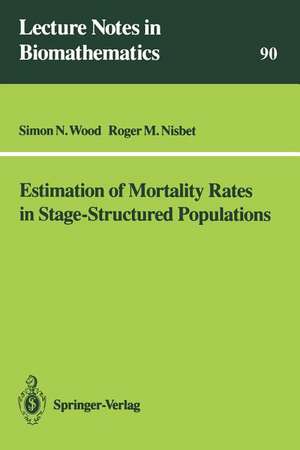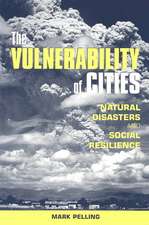Estimation of Mortality Rates in Stage-Structured Population: Lecture Notes in Biomathematics, cartea 90
Autor Simon N. Wood, Roger M. Nisbeten Limba Engleză Paperback – 7 aug 1991
Din seria Lecture Notes in Biomathematics
-
 Preț: 378.54 lei
Preț: 378.54 lei -
 Preț: 380.45 lei
Preț: 380.45 lei -
 Preț: 413.37 lei
Preț: 413.37 lei -
 Preț: 390.63 lei
Preț: 390.63 lei -
 Preț: 396.24 lei
Preț: 396.24 lei -
 Preț: 387.38 lei
Preț: 387.38 lei -
 Preț: 385.08 lei
Preț: 385.08 lei - 5%
 Preț: 366.56 lei
Preț: 366.56 lei -
 Preț: 384.70 lei
Preț: 384.70 lei -
 Preț: 388.13 lei
Preț: 388.13 lei -
 Preț: 394.29 lei
Preț: 394.29 lei - 5%
 Preț: 389.93 lei
Preț: 389.93 lei - 5%
 Preț: 370.74 lei
Preț: 370.74 lei -
 Preț: 384.86 lei
Preț: 384.86 lei -
 Preț: 387.96 lei
Preț: 387.96 lei -
 Preț: 404.29 lei
Preț: 404.29 lei -
 Preț: 391.61 lei
Preț: 391.61 lei -
 Preț: 384.48 lei
Preț: 384.48 lei -
 Preț: 384.48 lei
Preț: 384.48 lei -
 Preț: 383.71 lei
Preț: 383.71 lei -
 Preț: 379.68 lei
Preț: 379.68 lei -
 Preț: 384.09 lei
Preț: 384.09 lei -
 Preț: 405.66 lei
Preț: 405.66 lei -
 Preț: 379.48 lei
Preț: 379.48 lei -
 Preț: 400.65 lei
Preț: 400.65 lei -
 Preț: 385.25 lei
Preț: 385.25 lei -
 Preț: 390.25 lei
Preț: 390.25 lei -
 Preț: 395.47 lei
Preț: 395.47 lei -
 Preț: 378.71 lei
Preț: 378.71 lei -
 Preț: 382.95 lei
Preț: 382.95 lei - 15%
 Preț: 578.01 lei
Preț: 578.01 lei -
 Preț: 380.84 lei
Preț: 380.84 lei -
 Preț: 405.66 lei
Preț: 405.66 lei -
 Preț: 399.12 lei
Preț: 399.12 lei -
 Preț: 410.66 lei
Preț: 410.66 lei -
 Preț: 385.62 lei
Preț: 385.62 lei - 5%
 Preț: 371.10 lei
Preț: 371.10 lei -
 Preț: 378.71 lei
Preț: 378.71 lei -
 Preț: 386.99 lei
Preț: 386.99 lei -
 Preț: 401.61 lei
Preț: 401.61 lei -
 Preț: 350.30 lei
Preț: 350.30 lei -
 Preț: 383.33 lei
Preț: 383.33 lei -
 Preț: 408.54 lei
Preț: 408.54 lei -
 Preț: 398.53 lei
Preț: 398.53 lei -
 Preț: 399.67 lei
Preț: 399.67 lei -
 Preț: 391.79 lei
Preț: 391.79 lei -
 Preț: 384.86 lei
Preț: 384.86 lei -
 Preț: 401.61 lei
Preț: 401.61 lei -
 Preț: 392.60 lei
Preț: 392.60 lei -
 Preț: 406.05 lei
Preț: 406.05 lei
Preț: 377.73 lei
Nou
Puncte Express: 567
Preț estimativ în valută:
72.28€ • 77.29$ • 60.26£
72.28€ • 77.29$ • 60.26£
Carte tipărită la comandă
Livrare economică 17 aprilie-01 mai
Preluare comenzi: 021 569.72.76
Specificații
ISBN-13: 9783540539797
ISBN-10: 3540539794
Pagini: 116
Ilustrații: VIII, 101 p.
Dimensiuni: 155 x 235 x 6 mm
Greutate: 0.17 kg
Editura: Springer Berlin, Heidelberg
Colecția Springer
Seria Lecture Notes in Biomathematics
Locul publicării:Berlin, Heidelberg, Germany
ISBN-10: 3540539794
Pagini: 116
Ilustrații: VIII, 101 p.
Dimensiuni: 155 x 235 x 6 mm
Greutate: 0.17 kg
Editura: Springer Berlin, Heidelberg
Colecția Springer
Seria Lecture Notes in Biomathematics
Locul publicării:Berlin, Heidelberg, Germany
Public țintă
ResearchCuprins
1: Introduction.- 1.1 Inverse problems in population ecology.- 1.2 Copepod mortality rate estimation.- 1.3 The theoretical problems of mortality estimation.- 1.4 Existing methods for mortality estimation.- 1.5 This monograph.- 2: Mortality Estimation Schemes Related to Stage Structured Population Models.- 2.1 Introduction.- 2.2 Preliminaries: mortality estimation for an unstructured population with known birth rate.- 2.3 Mortality estimation for a single stage of known duration.- 2.4 Instabilities associated with mortality estimators.- 2.5 Discussion.- 3: Cubic Splines and Histosplines.- 3.1 Introduction.- 3.2 A brief guide to splines.- 3.3 Cubic splines for exact or noisy histogram data.- 3.4 Choosing the smoothing parameter with covariant error terms.- 3.5 Two examples of the application of cubic area splines to age-structured population data.- 4: Population Surfaces: A New Method of Mortality Estimation.- 4.1 The structured population model.- 4.2 Preliminary estimation of population surface f(?,t).- 4.3 Characteristics of f(?,t).- 4.4 Error estimates.- 4.5 What to do about adults.- 4.6 A simpler method.- 4.7 Messy practicalities.- 4.8 Summary.- 5: Tests of the New Method.- 5.1 Parslow and Sonntag’s Lag-Manly model method.- 5.2 The method of Hay, Evans and Gamble.- 5.3 Manly’s (1987) method.- 5.4 Comparison and testing of the sophisticated and simplified versions of the new method.- 5.5 Discussion.- 6: Loch Ewe Copepods: Some Speculation (Written with S.J. Hay).- 6.1 The Loch Ewe mesocosm experiments.- 6.2 Stage durations.- 6.3 Modelling sampling error.- 6.4 Death rate patterns for the different copepod species in bag C2: comparison and speculation.- 7: Discussion.- 7.1 What we’ve done.- 7.2 Experimental suggestions.- 7.3 Production estimation.- 7.4Methodological improvements.- 7.5 The take home message.- References.
















